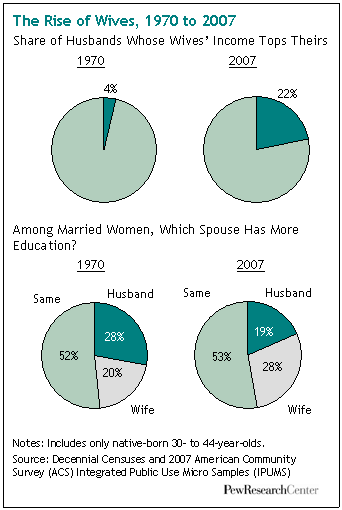Executive Summary

The institution of marriage has undergone significant changes in recent decades as women have outpaced men in education and earnings growth. These unequal gains have been accompanied by gender role reversals in both the spousal characteristics and the economic benefits of marriage.
A larger share of men in 2007, compared with their 1970 counterparts, are married to women whose education and income exceed their own, according to a Pew Research Center analysis of demographic and economic trend data. A larger share of women are married to men with less education and income.
From an economic perspective, these trends have contributed to a gender role reversal in the gains from marriage. In the past, when relatively few wives worked, marriage enhanced the economic status of women more than that of men. In recent decades, however, the economic gains associated with marriage have been greater for men than for women.
In 2007, median household incomes of three groups — married men, married women and unmarried women — were about 60% higher than those of their counterparts in 1970. But for a fourth group, unmarried men, the rise in real median household income was smaller — just 16%. (These household income figures are adjusted for household size and for inflation. For more details, see the methodology in Appendix B in the full report.)
Part of the reason for the superior gains of married adults is compositional in nature. Marriage rates have declined for all adults since 1970 and gone down most sharply for the least educated men and women. As a result, those with more education are far more likely than those with less education to be married, a gap that has widened since 1970. Because higher education tends to lead to higher earnings, these compositional changes have bolstered the economic gains from being married for both men and women.
There also is an important gender component of these trends. Forty years ago, the typical man did not gain another breadwinner in his household when he married. Today, he does — giving his household increased earning power that most unmarried men do not enjoy. The superior gains of married men have enabled them to overtake and surpass unmarried men in their median household income.
This report examines how changes at the nexus of marriage, income and education have played out among U.S.-born men and women who are ages 30-44 — a stage of life when typical adults have completed their education, gone to work and gotten married.1 Americans in this age group are the first such cohort in U.S. history to include more women than men with college degrees.
In 1970, 28% of wives in this age range had husbands who were better educated than they were, outnumbering the 20% whose husbands had less education. By 2007, these patterns had reversed: 19% of wives had husbands with more education, versus 28% whose husbands had less education. In the remaining couples — about half in 1970 and 2007 — spouses have similar education levels.
Along the same lines, only 4% of husbands had wives who brought home more income than they did in 1970, a share that rose to 22% in 2007.2
This reshuffling of marriage patterns from 1970 to 2007 has occurred during a period when women’s gains relative to men’s have altered the demographic characteristics of potential mates. Among U.S.-born 30- to 44-year-olds, women now are the majority both of college graduates and those who have some college education but not a degree. Women’s earnings grew 44% from 1970 to 2007, compared with 6% growth for men. That sharper growth has enabled women to narrow, but not close, the earnings gap with men. Median earnings of full-year female workers in 2007 were 71% of earnings of comparable men, compared with 52% in 1970.
The national economic downturn is reinforcing these gender reversal trends, because it has hurt employment of men more than that of women. Males accounted for about 75% of the 2008 decline in employment among prime-working-age individuals (U.S. Bureau of Labor Statistics, 2009). Women are moving toward a new milestone in which they constitute half of all the employed. Their share increased from 46.5% in December 2007 to 47.4% in December 2009.
Overall, married adults have made greater economic gains over the past four decades than unmarried adults. From 1970 to 2007, their median adjusted household incomes, the sum of financial contributions of all members of the household, rose more than those of the unmarried.
Educational attainment plays an important role in income, so a central focus of this report is to analyze economic data by level of schooling. Through this lens, too, married people have outdone the unmarried. The higher their education level, the more that adults’ household incomes have risen over the past four decades; within each level, married adults have seen larger gains than unmarried adults. Among married adults at each education level, men had larger household income increases than did women. Those who gained most of all were married male college graduates, whose household incomes rose 56%, compared with 44% for married female college graduates.3
For unmarried adults at each level of education, however, men’s household incomes fared worse than those of women. Unmarried women in 2007 had higher household incomes than their 1970 counterparts at each level of education. But unmarried men without any post-secondary education lost ground because their real earnings decreased and they did not have a wife’s wages to buffer that decline. Unmarried men who did not complete high school or who had only a high school diploma had lower household incomes in 2007 than their 1970 counterparts did. Unmarried men with some college education had stagnant household incomes.
Unmarried men with college degrees made gains (15%), but the gains were not as great as those for unmarried women with college degrees (28%). In fact, household incomes of unmarried men with college degrees grew at half the rate of household incomes of married men with only a high school diploma — 33% versus 15%.
There is an important exception to the rule that married adults have fared better than unmarried adults from 1970 to 2007. Married women without a high school diploma did not make the same gains as more educated women: Their household incomes slipped 2% from 1970 to 2007, while those of their unmarried counterparts grew 9%. The stagnant incomes of married women without high school diplomas reflect the poor job prospects of less educated men in their pool of marriage partners. These less educated married women now are far less likely than in the past to have a spouse who works — 77% did in 2007, compared with 92% in 1970.
Patterns by Education Level
Americans are considerably better educated than they were four decades ago, which has enabled many adults to upgrade the educational credentials of their spouses. Among adults without high school educations and those with high school diplomas but no further schooling, a larger share in 2007, compared with their counterparts in 1970, had spouses with more education than they had.
Among adults with some coll ege education, the pool of potential wives has expanded more rapidly than the pool of potential husbands. In this group, a higher share of men in 2007 had wives with more education than they did — 28% had a wife with a college degree in 2007, compared with 9% in 1970. Women with some college education in 2007 were less likely to have a husband with a college degree than their counterparts were in 1970 — 21% versus 39%.
Among college-educated adults, married men are markedly more likely to have a wife who is college educated — only 37% did in 1970, compared with 71% in 2007. College-educated married women, though, are somewhat less likely to have a college-educated husband — 70% did in 1970 and 64% did in 2007. (The figures differ from the perspective of husbands and wives because some U.S.-born 30- to 44-year-olds have spouses who are older, younger or foreign born.)
Of course, marriage does not increase household financial resources if the spouse does not work. Here, too, there has been great change. In 1973, only 45% of all women ages 16 and older were in the labor force. By 2007 this share had increased to 59%.4 Much of this increase is attributed to married women and to women with higher levels of education (Juhn and Potter, 2006). Furthermore, a sharp rise in workplace activity was reported among women married to higher-income men (Mulligan and Rubinstein, 2008). Among U.S.-born adults ages 30-44, most married men did not have a working spouse in 1970; now, most do. Married women, on the other hand, are somewhat less likely than their 1970 counterparts to have a husband who works.
Decline of Marriage
The shifts in the educational attainment and earnings capacity that men and women bring to marriage have played out against fundamental changes in the institution of marriage itself. These days, Americans are more likely than in the past to cohabit, divorce, marry late or not marry at all. There has been a marked decline in the share of Americans who are currently married. Among U.S.-born 30- to 44-year-olds, 60% were married in 2007, compared with 84% in 1970.
There is an education component to this change: The decline in marriage rates has been steepest for the least educated, especially men, and smallest for college graduates, especially women. College graduates, the highest earners, are more likely today to be married than are Americans with less education — 69% for adults with a college degree versus 56% for those who are not a college graduate.
That was not the case in 1970, when all education groups were about equally likely to wed. Among college-educated men, 88% were married in 1970, compared with 86% of men without a college education. Among women, the comparable 1970 figures were 82% and 83%.
Thus, Americans who already have the largest incomes and who have had the largest gains in earnings since 1970 — college graduates — have fortified their financial advantage over less educated Americans because of their greater tendency to be married.
Race Patterns
There are notable differences by race in the education, marriage and income patterns of U.S.-born adults ages 30-44. Black marriage rates, already lower than those of whites in 1970, have dropped more sharply since then, especially for the least educated. Only 33% of black women and 44% of black men were married in 2007.
Although black men and women had higher household income growth than men and women overall, the sharp decline in marriage rates among blacks hindered growth in their incomes. Among black women with high school educations, household incomes actually declined from 1970 to 2007, reflecting a change in the composition of this group from majority married (with the higher incomes that accompany this status) to majority unmarried.’
Read the full report for more details.




